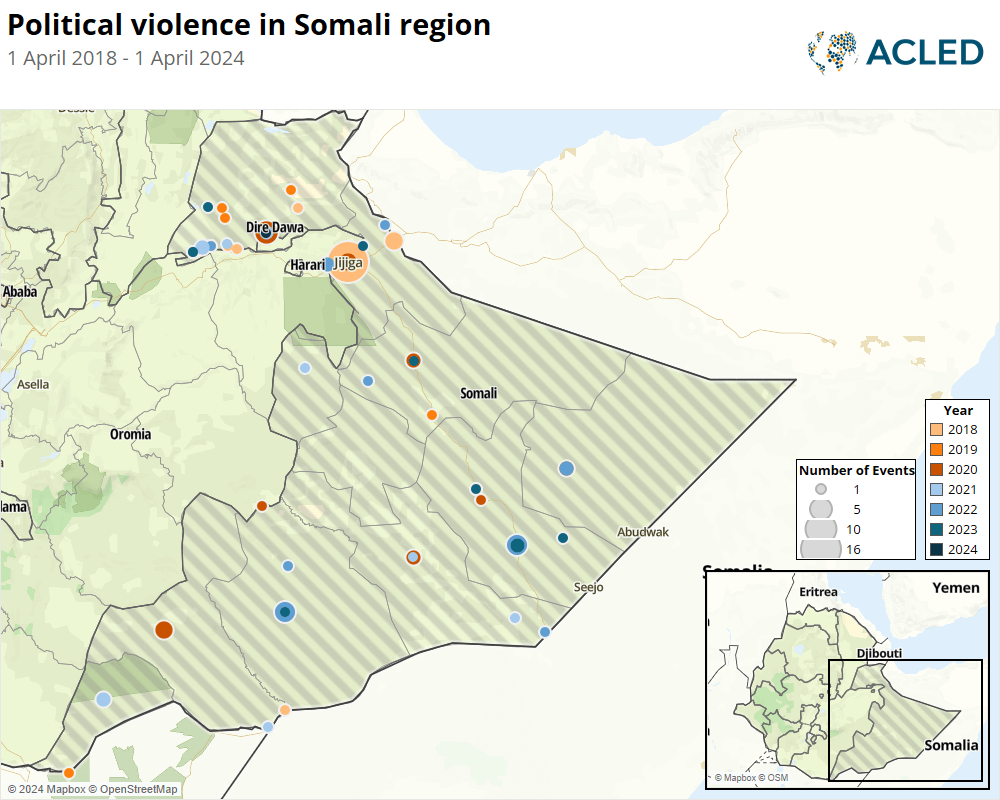Last updated: 08/08/2024
Somali is the second-largest region in Ethiopia after Oromia region. Somali shares borders with Afar region, Oromia region, and Dire Dawa city to the west. Djibouti lies to the region’s north, the de facto state Somaliland to the northeast, Somalia from east to south, and Kenya to the southwest. While Somali region is predominantly inhabited by the Somali ethnic group, it is ethnically heterogeneous. The Somalis in Ethiopia have social and political links with other ethnic Somalis in the neighboring countries; in Somali culture, clan links are the most important social and political unit of organization. According to the last official census conducted by the federal government in 2007, the Somali ethnic group was the third-largest ethnic group in the country.1Federal Democratic Republic of Ethiopia Population Census Commission, ‘Summary and Statistical Report of the 2007 Population and Housing Census,’ December 2008 By April 2022, it was estimated that the population in Somali region was around 6 million.2UNICEF, ‘Somalia Regional Brief,’ April 2022
The capital city of Somali region is Jigjiga. The region is divided into nine administrative zones — Shinile, Jigjiga, Degehabur, Warder, Korahe, Fik, Gode, Afder, and Liben — and 53 kebeles.
Conflict in Somali region
Somali region has long witnessed significant levels of violence. This high level has been driven by contests between former rebel organization Ogaden National Liberation Front (ONLF) and the federal government, and by local clan conflicts that cross domestic and international borders. However, after the disarming of the ONLF and the arrest of former Regional President Abdi Mohammed Omer (known as Abdi Illey) in August 2018, the levels of violence in the region have dropped significantly.
Historically, conflict along Somali region’s borders has been common, manifesting violence that spreads beyond local disagreements. Since the establishment of ethnic federalism in 1994, several of the region’s borders with Afar and Oromia have been disputed. With Oromia region alone, there were border disputes in over 420 kebeles after the establishment of the regions in 1994.3BBC, ‘What is behind clashes in Ethiopia’s Oromia and Somali regions?’ 18 September 2017 Aiming to resolve these disputes, a referendum was held in 2004, that resulted in the placement of 80% of the disputed kebeles under Oromia, though most of the demarcations have not yet been implemented. Thus, there are violent disputes at the borders of the two regions.
Somali region has border disputes over three kebeles located in Afar’s Awsi Rasu-Zone 1 and Gabi Rasu-Zone 3, and Somali’s Siti zone of Adaytu kebele in Mille woreda, Undufo kebele in Gewane woreda, and Gedamaytu kebele in Amibara woreda. The Issa clan, which inhabits these areas, wants to be part of Somali region, while Afar region considers the area an integral part of Afar. Although an agreement between the two regions recognizes the three kebeles as special kebeles within the Afar regional boundary, Issa clan elders (or Ugaz) oppose this agreement. As such, the conflict is ongoing (for more details, see the EPO’s Afar-Somali Border Conflict profile).
As the rest of the country celebrated the fall of the Tigray People’s Liberation Front in 2018, along with a perceived opening of political space and new freedoms, Somali region remained under the control of Abdi Illey and the Somali regional special forces, infamously known as Liyu police. These actors were accused of engaging in abuses of the civilian population as they battled ONLF forces.4Human Rights Watch,’“We are Like the Dead” Torture and other Human Rights Abuses in Jail Ogaden, Somali Regional State, Ethiopia,’ 4 July 2018 Demonstrations by residents of the region who opposed Abdi Illey’s rule erupted throughout April, May, and June 2018, and culminated in three days of intense violence in the capital city of the region, Jigjiga.
On 3 August 2018, clashes broke out between the Ethiopian military and Somali regional special forces in Jigjiga town amid reports that government troops had been deployed to arrest local politicians, including the regional president, resulting in a stand-off with the Somali regional president, Abdi Illey (see map below). The military occupied a number of key sites throughout the town. Over the next two days, a group of youths (referred to locally as Heego), allegedly supporting Abdi Illey, burned down several churches and looted shops and banks. Some reports indicate that the Heego attacked non-Somalis, particularly Oromos, in the town. Over the three days of violence, 29 people were reportedly killed. Abdi Illey was arrested, and a new regional president was confirmed.5Tobias Hagmann and Mustafe Mohamed Abdi, ‘Inter-ethnic violence in Ethiopia’s Somali Regional State, 2017 – 2018,’ London School of Economics and Political Science, March 2020 The arrest came after Human Rights Watch accused Abdi Illey of human rights violations and inciting ethnic and religious violence in the region.6Deutsche Welle, ‘Ethiopia arrests former Somali region leader,’ 28 August 2018

Since the removal of Abdi Illey, the region has been relatively peaceful, although tensions could be building. Movements by al-Shabaab from neighboring Somalia have been observed in the region. In July 2022, al-Shabaab and Somali regional special forces engaged in multi-day clashes in Afder zone in Somali region in Ethiopia, as well as in Yeed and Ato in Somalia (for more, see the EPO Weekly: 16-22 July 2022). This led to the deployment of thousands of Ethiopian troops into Somalia, establishing bases near the town of Dolow, southwest of where the attacks and clashes occurred.7Mohamed Dhaysane, ‘Ethiopia Deploys New Troops into Neighboring Somalia,’ Voice of America, 8 August 2022 In 2023, ACLED also records sporadic identity-based conflicts, as well as cross-border conflicts between clans in Somali region, other clans in Somalia, and Oromos in Oromia region. Most of the conflicts are related to resources like land or water.

